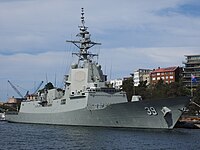Beatavician Armed Forces
This article is incomplete because it is pending further input from participants, or it is a work-in-progress by one author. Please comment on this article's talk page to share your input, comments and questions. Note: To contribute to this article, you may need to seek help from the author(s) of this page. |
| Beatavician Armed Forces B.A.F. | |
|---|---|
 | |
| Active | 23 June 1820 (204 years, 5 months ago) |
| Country | Beatavic |
| Allegiance | Government of Beatavic, Prime Minister of Beatavic |
| Size | Total - 462,000 Active Duty - 340,500 Reserve members - 121,500 |
| Engagements | |
| Commanders | |
| Prime Minister of Beatavic | Carter Nelson |
| Secretary of Defense | Michael Graham |
| Secretary of the Army | Albert-Jan Edelijn |
| Secretary of the Navy | Spencer Cohen |
| Secretary of the Air Force | Toos Koersen |
The Beatavician Armed Forces are in charge of guaranteeing the sovereignty and independence of the Republic of Beatavic, defending its territorial integrity and the constitutional order, according to the functions entrusted to them by the Constitution of 1820. They are composed of: the Army, the Air Force, the Navy, and the Military Emergencies Unit. Beatavic has one of the most powerful militaries in Nortua and holds a prominent place in the Sotoan Basin Union.
The Beatavician military has its roots in the Constantio Empire as a regional militia. During the War of Independence, it was more professionally structured and quickly grew into one of the most influential militaries in Nortua, expanding to a global influence with bases in other nations by the beginning of the 20th century. With the attack on Port Badmun and Beatavic's introduction into the World War, the military became a vital part of the allied efforts. However, in the aftermath of the World War the influence of Beatavic's armed forces degraded, and culminated in its fracturing during the 1998-2002 civil war. In the years since the civil war, Beatavic's military has been restructured and rebuilt and its prominence has begun to recover.
History
Branches
The Beatavician armed forces are a professional force with a strength in 2022 of 340,500 active personnel and 121,500 reserve personnel.
Army
The Beatavician Army consists of 18 active brigades and 6 military regions. Modern infantry have diverse capabilities and this is reflected in the varied roles assigned to them. There are four operational roles that infantry battalions can fulfil: air assault, armoured infantry, mechanised infantry, and light role infantry.
Air Force
The Beatavician Air Force currently has 16 fighter squadrons, each with 18-24 airplanes. The Air Force also has 15 operational air bases around the country. The Air Force operates a wide-ranging fleet of aircraft, from fighters to transport aircraft and passenger transports to helicopters. It maintains some 550 aircraft in total, of which around 230 are fighter aircraft. The Beatavic Air Force is replacing older aircraft in the inventory with newer ones including the domestically-produced H-29 Bear and H-31 Red Deer fighter jets, and the purchase of 2 Hartling-9s, 20 Z-11 Eagles and 4 Z-14 Ospreys.
Equipment
Naval vessels in the Beatavician Navy utilize the ship prefix RBNS or R.B.N.S., meaning Republic of Beatavic Naval Ship. The Navy is comprised of three aircraft carriers, 13 destroyers, 32 cruisers, 14 frigates, 7 submarines, and dozens of patrol vessels.
- Beatavic Navy
The Herder-class air warfare destroyer.
The Braker-class guided-missile cruiser.
The Bausch-class guided-missile cruiser.
The Buseman-class submarine is a diesel-electric fast-attack submarine.
Aircraft carriers
The Beatavic Navy has three operational aircraft carriers, two of which are domestically produced Stolte-class aircraft carriers, and one Hamilton-class aircraft carrier purchased from Zamastan. The Stolte-class is equipped with short take-off and vertical landing (STOVL) aircraft and helicopters, and the ship is powered by four gas turbines offering a sustained power of 81,000 hp (60 MW). Driving two shafts the ship has a maximum speed of 30 knots (56 km/h; 35 mph) and can travel for 7,000 nautical miles (13,000 km; 8,100 mi) at around 20 knots (37 km/h; 23 mph).
- RBNS Essen, named after Naud Essen
- RBNS Cerfontain, named after Koen Cerfontain
- RBNS Grizzly, named after the national animal
Destroyers
The Beatavic Navy operates the Herder-class destroyer, which operates in the defense of a naval forces (plus assets ashore) from aircraft and missile attack, while also operating in anti-surface, anti-submarine, and naval gunfire support roles.
- RBNS
- RBNS
- RBNS
- RBNS
- RBNS
- RBNS
- RBNS
- RBNS
- RBNS
- RBNS
- RBNS
- RBNS
- RBNS
Cruisers
The Beatavic Navy has three classes of guided-missile cruisers; the domestically produced Braker-class and Bausch-class, and two Tregueux-class vessels supplied by Zamastan.
Braker-class:
- RBNS
- RBNS
- RBNS
- RBNS
- RBNS
- RBNS
- RBNS
- RBNS
- RBNS
- RBNS
- RBNS
- RBNS
- RBNS
- RBNS
- RBNS
- RBNS
- RBNS
- RBNS
- RBNS
- RBNS
- RBNS
Bausch-class:
- RBNS
- RBNS
- RBNS
- RBNS
- RBNS
- RBNS
- RBNS
- RBNS
- RBNS
Tregueux-class:
- RBNS
- RBNS
Frigates
The Beatavic Navy's only class of frigate is the Lammertink-class frigate.
- RBNS
- RBNS
- RBNS
- RBNS
- RBNS
- RBNS
- RBNS
- RBNS
- RBNS
- RBNS
- RBNS
- RBNS
- RBNS
- RBNS
Submarines
Beatavic's naval forces utilize two classes of submarine; the domestically produced Buseman-class and one Zamastanian-supplied Jade-class nuclear submarine.
- RBNS
- RBNS
- RBNS
- RBNS
- RBNS
- RBNS





